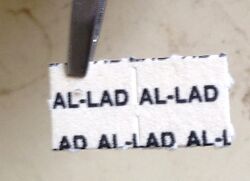Chemistry:AL-LAD
 | |
| Legal status | |
|---|---|
| Legal status |
|
| Identifiers | |
| |
| CAS Number | |
| PubChem CID | |
| ChemSpider | |
| UNII | |
| ChEMBL | |
| Chemical and physical data | |
| Formula | C22H27N3O |
| Molar mass | 349.478 g·mol−1 |
| 3D model (JSmol) | |
| |
| |
| | |
AL-LAD, also known as 6-allyl-6-nor-LSD, is a psychedelic drug and an analog of lysergic acid diethylamide (LSD).[2] It is described by Alexander Shulgin in the book TiHKAL (Tryptamines i Have Known And Loved). It is synthesized starting from nor-LSD as a precursor, using allyl bromide as a reactant.
Effects in humans
While AL-LAD has subtly different effects than LSD, and appears to be slightly shorter lasting, their potencies are similar;[3][4] an active dose of AL-LAD is reported to be between 50 and 150 micrograms.[5] AL-LAD has a known but short and highly uncommon history of recreational human use, which originated in Ireland and the UK, but spread internationally.[citation needed]
Chemistry
AL-LAD does not cause a color change with the Marquis, Mecke or Mandelin reagents,[6] but does cause the Ehrlich's reagent to turn purple because of the presence of the indole moiety in its structure.
Legal status
AL-LAD is not scheduled by the United Nations ' Convention on Psychotropic Substances.[7]
Denmark
AL-LAD is illegal in Denmark.[8]
Finland
Listed in a decree of the government's psychoactive substances banned from the consumer market.[9][10]
Latvia
AL-LAD is possibly illegal in Latvia. Although it isn't specifically scheduled, it may be controlled as an LSD structural analog due to an amendment made on June 1, 2015.[11]
Sweden
The Riksdag added AL-LAD to Narcotic Drugs Punishments Act under Swedish schedule I ("substances, plant materials and fungi which normally do not have medical use" ) as of January 26, 2016, published by Medical Products Agency (MPA) in regulation HSLF-FS 2015:35 listed as 6-allyl-6-nor-LSD, AL-LAD, and 6-allyl-N,N-dietyl-9,10-didehydroergolin-8-karboxamid.[12]
Switzerland
AL-LAD is illegal in Switzerland.[13]
United Kingdom
AL-LAD is illegal in the UK. On June 10, 2014 the UK Advisory Council on the Misuse of Drugs (ACMD) recommended that AL-LAD be specifically named in the UK Misuse of Drugs Act as a class A drug despite not identifying any harm associated with its use.[14] The UK Home office accepted this advice and announced a ban of the substance to be enacted on 6 January 2015 as part of The Misuse of Drugs Act 1971 (Amendment) (No. 2) Order 2014.
United States
AL-LAD is a Controlled Substance at the federal level in the United States ,[15] AL-LAD is legally considered an analog of LSD, therefore, sales or possession with intent for human consumption could be prosecuted under the Federal Analogue Act.[16]
See also
References
- ↑ "Arrêté du 20 mai 2021 modifiant l'arrêté du 22 février 1990 fixant la liste des substances classées comme stupéfiants". Journal officiel de la République française. 20 May 2021. https://www.legifrance.gouv.fr/jorf/id/JORFTEXT000043523554.
- ↑ "6 -allyl-6-norlysergic acid diethylamide (AL-LAD) and (2'S,4'S)-lysergic acid 2,4-dimethylazetidide (LSZ)". Drug Testing and Analysis 9 (1): 38–50. January 2017. doi:10.1002/dta.1985. PMID 27265891.
- ↑ "NPS: Medical Consequences Associated with Their Intake". Current Topics in Behavioral Neurosciences. 32. Springer International Publishing. June 2016. pp. 351–380. doi:10.1007/7854_2016_15. ISBN 978-3-319-52442-9. OCLC 643052237. https://link.springer.com/bookseries/7854.
- ↑ "Synthesis and LSD-like discriminative stimulus properties in a series of N(6)-alkyl norlysergic acid N,N-diethylamide derivatives". Journal of Medicinal Chemistry 28 (9): 1252–5. September 1985. doi:10.1021/jm00147a022. PMID 4032428.
- ↑ TiHKAL: The Continuation. Berkeley, California: Transform Press. 1997. p. 392. ISBN 978-0-9630096-9-2. https://www.erowid.org/library/books_online/tihkal/tihkal26.shtml.
- ↑ Ecstasydata. "AL-LAD (Not sold as ecstasy)". EcstasyData.org. http://www.ecstasydata.org/view.php?id=2829.
- ↑ "Conventions". https://www.unodc.org/unodc/en/commissions/CND/conventions.html.
- ↑ "Lists of euphoriant substances". The Danish Medicines Agency. September 2015. http://laegemiddelstyrelsen.dk/en/licensing/company-authorisations-and-registrations/euphoriant-substances/lists-of-substances.
- ↑ "FINLEX ® - Säädökset alkuperäisinä: Valtioneuvoston asetus kuluttajamarkkinoilta… 166/2016". https://www.finlex.fi/fi/laki/alkup/2016/20160166. Retrieved June 11, 2023.
- ↑ "FINLEX ® - Säädökset alkuperäisinä: Valtioneuvoston asetus kuluttajamarkkinoilta… 225/2017" (in fi). https://www.finlex.fi/fi/laki/alkup/2017/20170225. Retrieved June 11, 2023.
- ↑ "Noteikumi par Latvijā kontrolējamajām narkotiskajām vielām, psihotropajām vielām un prekursoriem". http://likumi.lv/doc.php?id=121086.
- ↑ "Gemensamma författningssamlingen avseende hälso- och sjukvård, socialtjänst, läkemedel, folkhälsa m.m." (in sv). Lakemedelsverket. https://lakemedelsverket.se/upload/lvfs/HSLF-FS/HSLFS-FS_2015_35.pdf.
- ↑ "Verordnung des EDI über die Verzeichnisse der Betäubungsmittel, psychotropen Stoffe, Vorläuferstoffe und Hilfschemikalien" (in de). Der Bundesrat. https://www.admin.ch/opc/de/classified-compilation/20101220/index.html.
- ↑ ACMD (10 June 2014). "Update of the Generic Definition for Tryptamines". UK Home Office. p. 12. https://www.gov.uk/government/uploads/system/uploads/attachment_data/file/318693/UpdateGenericDefinitionTryptamines.pdf.
- ↑ "PART 1308 - Section 1308.11 Schedule I". http://www.deadiversion.usdoj.gov/21cfr/cfr/1308/1308_11.htm.
- ↑ "Erowid Analog Law Vault : Federal Controlled Substance Analogue Act Summary". https://www.erowid.org/psychoactives/law/analog/analog_info1.shtml.
Further reading
- "LSD and structural analogs: pharmacological evaluation at D1 dopamine receptors". Psychopharmacology 118 (4): 401–9. April 1995. doi:10.1007/BF02245940. PMID 7568626.
- "[Studies on lysergic acid diethylamide and related compounds. IV. Syntheses of various amide derivatives of norlysergic acid and related compounds]". Yakugaku Zasshi 96 (5): 673–8. May 1976. doi:10.1248/yakushi1947.96.5_673. PMID 987200.
- "Lysergamides revisited". Hallucinogens: An Update. NIDA Research Monograph. 146. United States Department of Health and Human Services. 1994. pp. 52–73. http://archives.drugabuse.gov/pdf/monographs/146.pdf.
External links
 |


